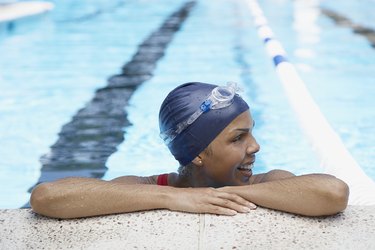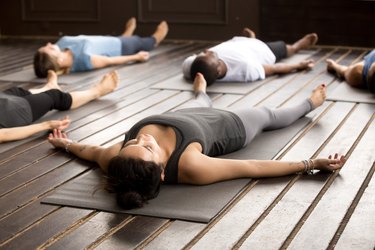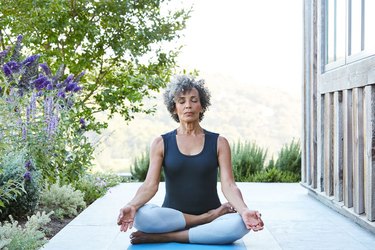
Here's a tough contradiction: There's an association between exercise and a reduced risk of psoriasis flares, according to an August 2012 study in JAMA Dermatology. But for many who have the autoimmune disease, the scaly irritated patches — called plaques —along with pain, inflammation and fatigue can make working out challenging.
That can be particularly true because stress is a common trigger for a psoriasis flare, according to the National Psoriasis Foundation, and walking into a new gym situation or taking on a fresh fitness goal may seem overwhelming enough to make flares a possibility.
Video of the Day
Video of the Day
It's also worth noting that exercise itself is a form of stress on your body, according to the Physiological Society, because it challenges homeostasis, or your body's need to maintain a state of equilibrium.
Fortunately, there are ways to reap the benefits of exercise while keeping the risk of exacerbating your condition lower. Consider the following expert-backed options.
1. Take Up Swimming
There are many reasons swimming tends to be a top-recommended exercise for people with psoriasis, Enrizza P. Factor, MD, clinical dermatologist and researcher for My Eczema Team, tells LIVESTRONG.com. The activity is low-impact and easy on joints, which is helpful for inflammation, and if you're in salt water, it can slough off dead skin, she says.
The caveat here is that chlorinated water can dry out skin and leave it flaky. Dr. Factor suggests balancing that out by making sure to shower afterward using a gentle cleanser and moisturize well.
2. Create a Routine
Establishing exercise as a habit is crucial, Dr. Factor says, because that can often help reduce stress. She says in addition to fitness, eating healthy foods, getting enough rest and staying connected to others are all part of an important routine.
"Stress is the biggest problem for people with psoriasis, and it can be a vicious cycle once it begins," she says. "When you have a flare, it can cause more worry or anxiety about that, which makes the flare worse, especially if it affects your sleep. A regular routine can help break that cycle."
3. Focus on Moderate Exercise
Although high-intensity exercise is fine on an occasional basis, those with psoriasis tend to do better with moderate-intensity workouts to keep the stress response more controlled, Tim Bailey, CPT, a trainer at TrainFitness International in London, tells LIVESTRONG.com. That's particularly true if sweat tends to be irritating to your skin.
"That doesn't mean you're limited to a narrow amount of exercise options," he says. "Think outside the box about how and where you can get exercise. It doesn't always mean heavy weights and cardio at the local gym."
Moderate exercise options can mean going for an easy run, a brisk walk, yoga, cycling and tai chi. Even housework and gardening can qualify as "movement is medicine" if you do them at a pace that feels slightly challenging but not enough to make you break a sweat.
4. Keep a Training Journal
Even if your exercise of choice is going for a fast walk every day, it's helpful to track distance, time and how you feel, Bailey suggests. If you do have a flare, you can look back at your training log and see if there are any factors that may have influenced the issue.
For example, maybe your flare happened when you began skipping that walk for a few days, which can tell you exercise may have been doing more to control your condition than you thought.
5. Focus on Skin Health Before and After
Using moisturizer right before you exercise is helpful, but be sure that's not the only time you soothe your skin, New York-based dermatologist Michele Green, MD, at Mount Sinai and Lenox Hill Hospital, tells LIVESTRONG.com.
"The more often you moisturize, the less irritated your skin will be overall, and the faster it tends to heal," she says.
If your skin is dry when you're exercising, you're at greater risk of developing minor scratches from equipment like free weights or kettlebells.
"If that happens, even these tiny nicks can increase risk of a flare or at least more irritation," she says.
Anti-itch creams can also be useful for keeping yourself from absentmindedly scratching at a plaque spot, Dr. Green adds.
Shop These Moisturizers and Anti-Itch Creams
- Curel Hydra Therapy Wet Skin Moisturizer ($11.69, Amazon.com)
- CeraVe Psoriasis Moisturizing Cream ($19.97, Amazon.com)
- Eucerin Skin Calming Itch Relief Treatment ($9.89, Amazon.com)
- Aveeno Anti-Itch Concentrated Lotion ($8.37, Amazon.com)
6. Cover a Plaque if Possible
It's not always realistic to cover every plaque area before exercising, because some may be on your neck or scalp. But when you can, Dr. Green suggests putting on moisturizer or anti-itch cream and then covering up with cloth that's breathable, like cotton, to help lower the risk of irritation.
She suggests avoiding regular gauze because it can absorb the lotion (instead of the skin absorbing the lotion) and actually make the plaque underneath less moisturized. There are options for sleeves and leg coverings designed for skin conditions like eczema and psoriasis made from breathable fabrics.
Shop These Arm and Leg Sleeves
- Soothems Sleeve for Psoriasis and Eczema Relief ($29.95, Soothems.com)
- AD Rescue Wear Sleeve for Arms and Legs ($29.95, EczemaReliefStore.com)
7. Talk to Your Doc, Listen to Your Body
The biggest tip: Consult the experts. That means listening to both your doctor and your body. Exercise can bring numerous advantages that help your psoriasis overall through better sleep, improved immune function and lower stress, but you still need to navigate around flare risks because working out creates physiological stress. Your doctor can recommend medications and therapies that may help, and your body will tell you when you're pushing too hard, too quickly.


